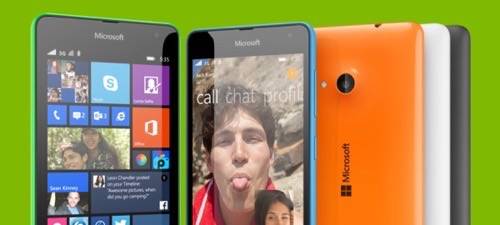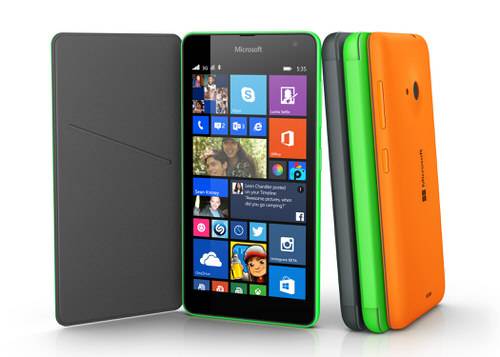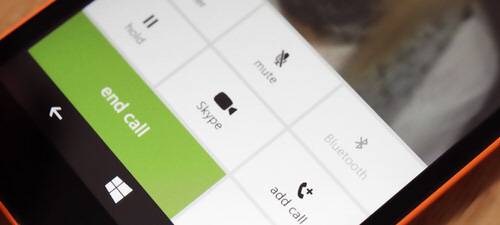
Microsoft just revealed its first post-Nokia Lumia smartphone Monday night—and in the process, its vision for its smartphone business.
With Microsoft’s Lumia 535, the company’s first act as a maker of both smartphone hardware and software was to announce a low-end phone. Alone, that’s noteworthy, but it also lands during the ramp up to the holiday season, a period when most device makers highlight their flagship phones or debut their droolworthiest devices.
Microsoft has no high-end flagship. Even after the Lumia 535’s launch this month, it still won’t. And, it seems, the company may just want to keep it that way.
Microsoft’s Scheme to Win Users

There’s not much difference between the new Lumia and old Lumias, apart from the extraction of the Nokia name. Microsoft’s moniker now appears on the front and back, along with a logo. Meanwhile, older smartphones in the collection will lose the Lumia name, going by Nokia only. Otherwise, the technicolor choices in plastic casings remain, as well as adequate (though not exciting) hardware specifications.
The 535 will start by launching in select Asian markets before going on to Russia and the Middle East in later months. Although tech companies often send plenty of low-cost phones overseas, few hang their whole mobile strategy on them. In Microsoft’s case, this budget device points to a broader overall strategy.
See also: Hello Neo: Nokia Exists Only In Movie Form (Mostly)
“Innovation should be available to everyone, and we are doing this through the very best integrated Microsoft services included and out of the box … all at an affordable price,” said Jo Harlow, corporate vice president for phones at Microsoft, in a press statement. That affordability could be key to the company’s focus—to become a leader in budget smartphones.
Tom Warren at The Verge noted, “With no new flagship Lumia devices planned this year, Microsoft is betting on low-end handsets to push Lumia sales and Windows Phone market share,” pointing out that this is straight out of Nokia’s Windows Phone playbook, before Microsoft acquired the Finnish company’s mobile business earlier this year. He also pointed to the company’s partnership with low-cost hardware vendors as further proof.
According to IDC, Microsoft’s Windows Phone platform sits in the third-place spot in the global smartphone rankings, behind Apple’s iOS and Google’s Android. If the company’s scheme is to boost sales and adoption by going full tilt at the low-cost market, it may choose to eschew the gigantic, beastly flagship phone war waged by the likes of the iPhone and Nexus.
Microsoft’s Lumia 535 Tries To Appeal To The People

In promoting the new Lumia, Harlow highlighted the company’s “5x5x5” proposition, which essentially amounts to five key Microsoft services—Skype, Office, OneDrive, Cortana and OneNote. Time for a reality check: Apart from Cortana, all of those services are available on Google’s Android and Apple’s iOS platforms. Not exactly a strong argument for Lumia’s must-have standing.
Then again, customers of the Lumia 535 might be thrilled that their inexpensive device comes with these “benefits.” They might even find the phone’s middling hardware satisfactory.
A year or two ago, the 535’s specs would’ve been considered very decent. Now they’re rather mediocre, which is no surprise considering the device’s low-cost orientation: The new Lumia features a 1.2GHz quad-core processor and 1GB RAM memory, which is hardly newsworthy these days. While it offers a wide-angle 5 megapixel front-facing camera, viewing selfies on a 5-inch qHD display (at 960 x 540 resolution) won’t wow anyone in a world rife with high-resolution super AMOLED screens.
Still, the phone should meet reasonable expectations for a budget device. The phone also comes in two models, the standard Lumia 535 and a dual SIM version, which can access a secondary cellular network—handy for people who travel a lot.
As a low-end offering, Microsoft’s Lumia 535 could appeal to folks who didn’t believe they could afford a decent smartphone. But as the lynchpin to the company’s whole mobile future, it becomes something more. It may be a sign of more Lumias to come—as well as Microsoft’s bid to go from scrappy mobile underdog to dominant smartphone platform of the people.
Images courtesy of Microsoft









